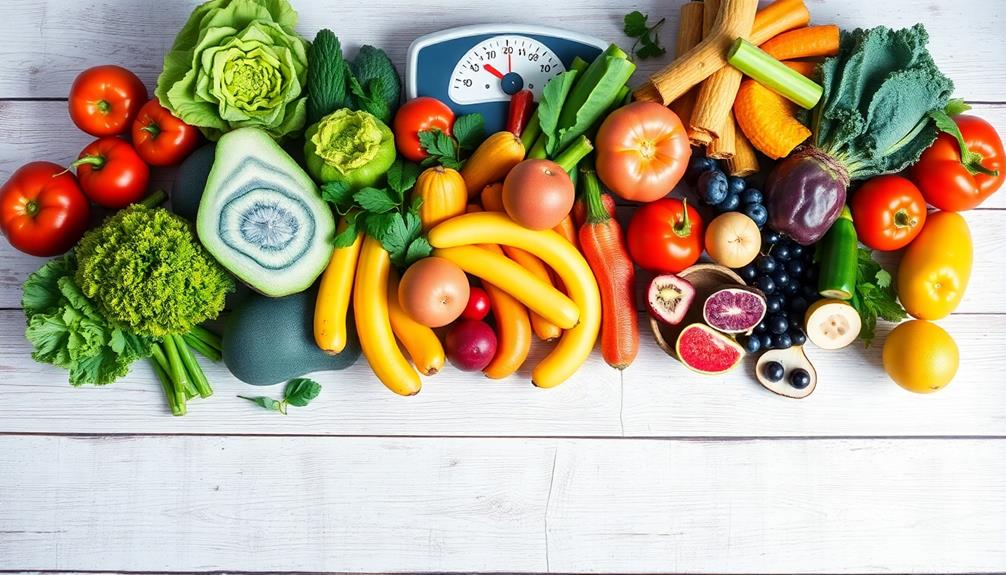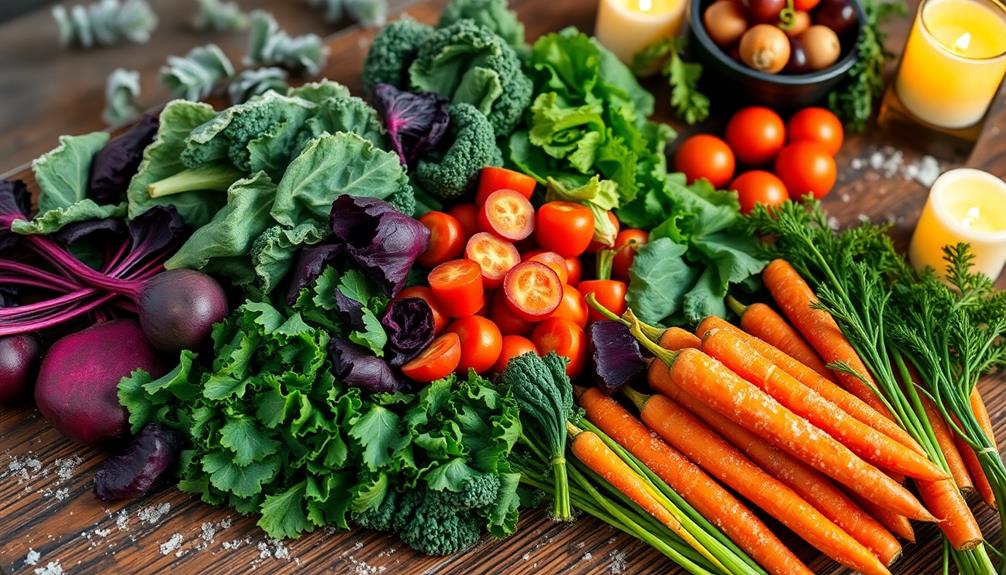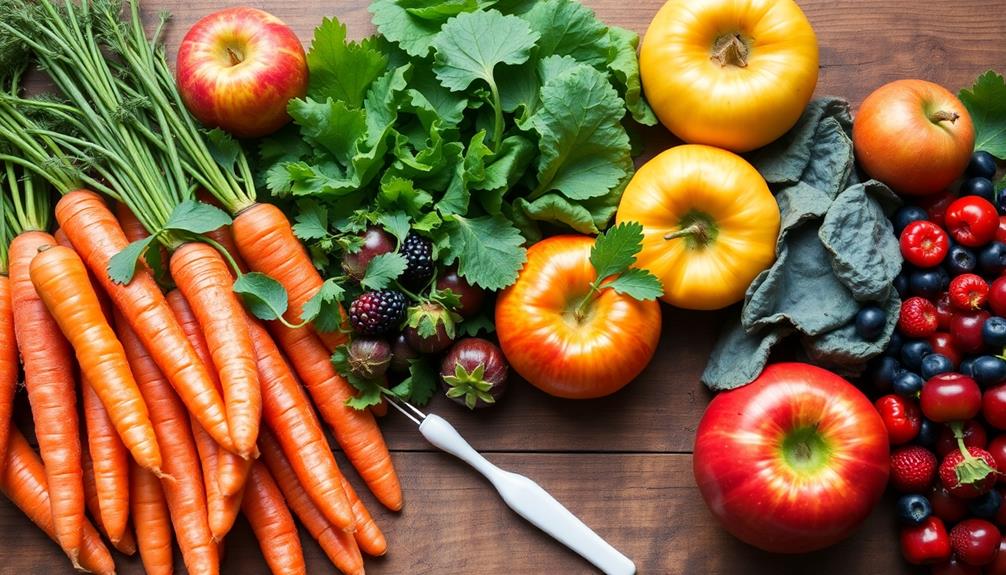The raw food diet can help you lose weight, but it's important to set realistic expectations. While it emphasizes nutrient-rich fruits, vegetables, and nuts, relying solely on raw foods could lead to nutrient deficiencies if not planned carefully. You'll need to consume a substantial amount of food daily to meet your caloric needs. This diet's restrictive nature may make it hard to maintain long-term. Combining raw and cooked foods can enhance nutrient absorption and offer better variety. If you're committed to this approach, there are effective strategies that can support your goals effectively.
Key Takeaways
- A raw food diet can promote weight loss through low-calorie, high-fiber foods that enhance feelings of fullness and reduce overall calorie intake.
- Creating a caloric deficit of about 500 calories daily is essential for sustainable weight loss, even when consuming raw foods.
- Incorporating a variety of raw and cooked foods can help prevent nutrient deficiencies and support overall health during weight loss efforts.
- Portion control is crucial with high-calorie raw foods like nuts and seeds to maintain an effective caloric deficit for weight loss.
- Setting realistic expectations for weight loss involves understanding the challenges of maintaining a raw diet, including meal preparation and nutrient planning.
Understanding the Raw Food Diet
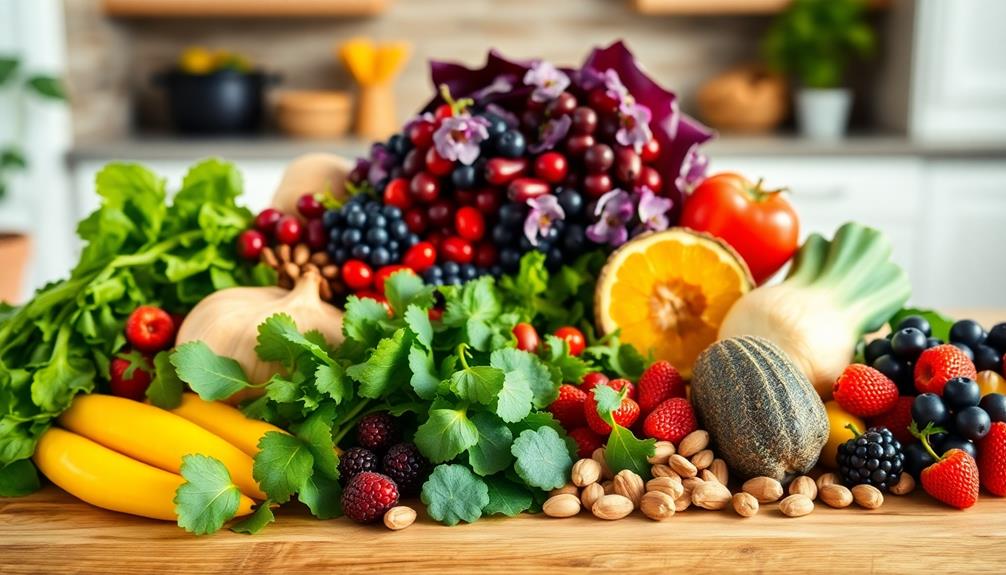
The raw food diet, often seen as a natural lifestyle choice, focuses on unprocessed foods like fruits, vegetables, nuts, and seeds, keeping heat exposure to a minimum. This approach emphasizes consuming raw fruits and vegetables, which are rich in nutrients and promote overall health. Many people adopt raw food diets to create a balanced diet that minimizes junk food consumption.
However, it's important to understand that long-term adherence to this plant-based diet can be challenging. While proponents argue that cooking destroys essential nutrients, it's vital to recognize that some nutrients, like lycopene in tomatoes, can actually become more bioavailable when cooked.
You might find variations of the raw food diet that include raw dairy, eggs, fish, and even meat, depending on personal preferences. Despite its popularity, you need to be aware of potential nutrient deficiencies, which can arise without careful planning.
While raw food diets can be effective for weight loss due to their high fiber and low calorie content, ensuring a balanced diet is essential for maintaining your health in the long term.
Nutritional Benefits and Drawbacks
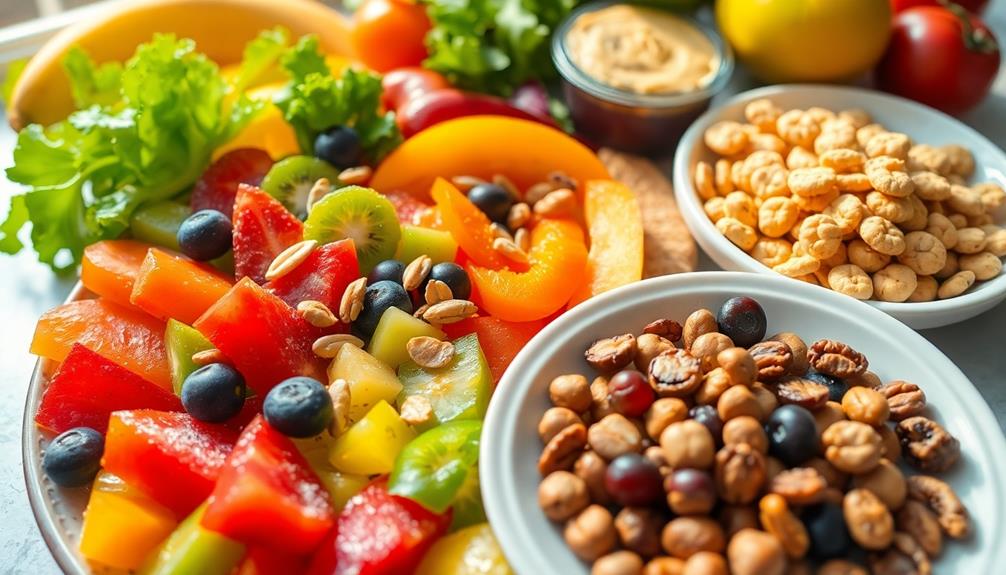
When you consider a raw food diet, it's crucial to look at both nutrient density and potential deficiencies.
While you'll get a boost in vitamins and minerals, including antioxidants that may protect brain cells certain teas linked to reduced dementia risk, you might also miss out on key nutrients like vitamin B12 and omega-3 fatty acids.
Balancing your intake and understanding these factors can help you make healthier choices.
Nutrient Density Considerations
Raw food diets offer a vibrant array of vitamins, minerals, and antioxidants that can boost your overall health and lower the risk of chronic diseases like heart disease and diabetes. The nutrient-rich nature of raw fruits and vegetables supports weight loss due to their low calorie density, making it easier to manage your intake.
Additionally, incorporating chia seeds and digestive health can enhance your diet as they're high in fiber and omega-3 fatty acids, promoting satiety and regularity. However, if you don't plan carefully, you might face nutrient deficiencies, particularly with essential nutrients like vitamin B12, iron, and omega-3 fatty acids.
While raw foods provide numerous health benefits, it's essential to evaluate food variety to meet your nutritional needs. Cooking can enhance the bioavailability of certain nutrients, such as lycopene found in tomatoes, which suggests a balanced approach that includes both raw and cooked foods might be ideal.
Additionally, be mindful of high-fat raw foods like nuts and seeds; while they're nutritious, excessive consumption can counteract your weight loss efforts if portion control isn't practiced. By combining raw food with mindful cooking, you can create a diet that maximizes nutrient density while supporting your overall health and weight loss goals.
Potential Deficiencies Awareness
Following a raw food diet can lead to potential nutrient deficiencies if you're not careful. While raw foods are rich in vitamins and minerals, they often lack vital nutrients like vitamin B12, iron, and omega-3 fatty acids. This can create nutrient imbalances and calorie deficiencies, especially if you rely heavily on fruits, which may result in mineral deficiencies and even tooth erosion due to their natural acids.
Additionally, incorporating aromatherapy for emotional well-being can help manage stress levels that may arise from dietary changes, promoting a more balanced approach to health.
To maintain a balanced nutrient intake, consider incorporating a mix of raw and cooked plant-based foods. Cooking enhances the bioavailability of certain nutrients, making them easier for your body to absorb. It's also essential to guarantee you're getting enough healthy fats and proteins, as a restrictive raw diet can lead to protein deficiencies, impacting your overall health.
Gradually increasing your fiber intake is key to avoid digestive issues, but remember that high fiber diets need adequate protein and healthy fats for balance.
Weight Loss Mechanisms Explained
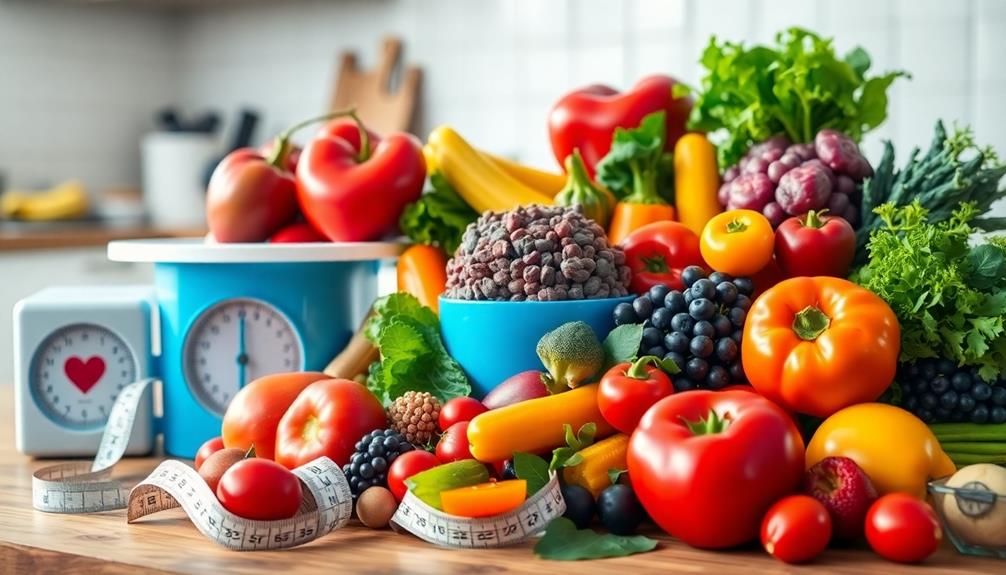
When you adopt a raw food diet, understanding the mechanisms behind weight loss can help you achieve your goals.
A focus on caloric deficit and nutrient density plays an essential role, as does how these foods can influence your metabolism.
Let's explore how these factors come together to support your weight loss journey.
Caloric Deficit Importance
To lose weight effectively, you need to create a caloric deficit, which means burning more calories than you consume. This principle holds true for any diet, including a raw food diet. By focusing on low-calorie density foods like fruits and vegetables, you can feel full while consuming fewer calories due to their high fiber content.
Here are some key points to take into account:
- Monitor your caloric intake: Keeping track of what you eat helps guarantee you're maintaining a caloric deficit.
- Aim for a deficit of about 500 calories daily: This can lead to a weight loss of roughly 1 pound per week.
- Balance your diet: While raw foods are nutritious, it's crucial to avoid energy deficiencies by including a variety of fruits and vegetables.
- Be cautious with high-calorie raw foods: Nuts and seeds can be healthy but can quickly reduce your caloric deficit if consumed in excess.
Nutrient Density Focus
Creating a caloric deficit is a fundamental step for weight loss, but the quality of the calories you consume matters just as much. A raw food diet, rich in nutrient-dense, high-fiber foods, can help you achieve this balance. By focusing on fresh produce and eliminating processed foods, you not only lower caloric intake but also enhance your body's metabolic processes.
Here's a quick comparison of nutrient density in various food types:
| Food Type | Nutrient Density |
|---|---|
| Fresh Fruits | High |
| Leafy Greens | High |
| Processed Foods | Low |
| Refined Sugars | Very Low |
Incorporating more plant-based foods into your meals can lead to significant weight loss over time. These foods are typically low in calorie density, allowing you to eat more while consuming fewer calories. Plus, the high fiber content helps control hunger and promotes satiety, reducing the likelihood of overeating. By embracing a raw food diet, you support stable blood sugar levels and ultimately create a sustainable path toward weight loss.
Metabolism and Raw Foods
While many diets may promise quick results, understanding the role of metabolism in weight loss is vital, especially with a raw food diet. When you embrace eating raw, you're often consuming low-calorie, high-fiber foods that can help you manage your weight effectively.
Here are some key points to take into account:
- Caloric Deficit: Raw foods are typically low in calorie density, helping you create a calorie deficit necessary for weight loss.
- Satiety: The high fiber content in raw foods can enhance feelings of fullness, reducing your overall calorie intake.
- Thermic Effect of Food (TEF): Raw foods may require more energy for digestion compared to cooked foods, potentially boosting your metabolism.
- Avoid Processed Foods: Adopting a raw vegan diet often leads to a decrease in high-calorie processed foods, facilitating weight loss.
However, it's important to be mindful of nutrient deficiencies and the risk of overeating calorie-dense raw foods like nuts and seeds.
Challenges of Maintaining a Raw Diet

Managing the challenges of a raw diet can be intimidating, especially when you realize the sheer volume of food required to meet your caloric needs—often around 8-10 pounds daily. This can lead to extensive meal preparation, making it difficult to sustain your commitment.
The restrictive nature of the diet may also trigger feelings of deprivation, particularly in social situations where tempting cooked foods are abundant.
Limited food options and the seasonal availability of organic produce can stifle variety in meals, leading to boredom and decreased motivation. Without enough diversity, you might struggle to stay engaged with the raw food lifestyle.
Additionally, there's a risk of nutrient deficiencies, such as vitamin B12 and iron, which necessitates careful planning to guarantee you're getting proper nutrition.
Costs associated with purchasing fresh, organic produce can strain your budget, and the time commitment for meal preparation can be overwhelming.
These factors can pose significant barriers to long-term adherence to a raw food diet, making it essential to weigh the pros and cons before diving in for weight loss. Understanding these challenges can help you set realistic expectations for your journey.
Practical Tips for Success
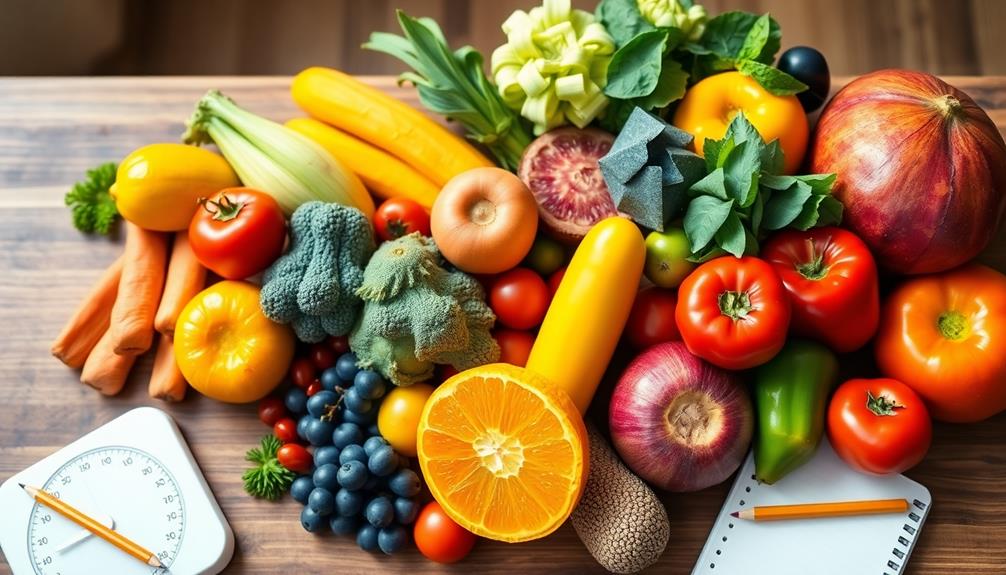
Steering through the raw food lifestyle can be challenging, but implementing practical strategies can make the journey smoother. Here are some tips to help you succeed:
1. Start Gradually: Begin by incorporating raw foods into your diet one meal at a time. Replacing just one cooked meal with a raw option can ease cravings and help you adjust.
2. Invest in Kitchen Tools: High-quality appliances like a blender and food processor can make meal prep enjoyable and efficient.
These tools enable you to create a variety of raw dishes effortlessly.
3. Choose Seasonal Produce: Focus on seasonal and locally sourced ingredients. Fresh produce not only tastes better but also enhances the quality of your raw meals, making it easier to stick to your diet.
4. Find a Support Group: Joining a community of raw food enthusiasts can provide motivation, share recipes, and offer tips.
Having support makes the journey more enjoyable and helps set realistic expectations for your weight loss goals.
Balancing Raw and Cooked Foods

Finding the right balance between raw and cooked foods can greatly enhance your nutritional intake and overall health. By incorporating both, you can improve nutrient absorption and enjoy a wider range of benefits. For instance, cooking tomatoes increases the bioavailability of lycopene, making it five times more accessible.
A varied diet helps prevent nutrient deficiencies, particularly in vitamins B12, D, iron, and omega-3 fatty acids, which are often missing in strict raw food diets.
Balancing raw and cooked foods also improves digestibility, reducing gastrointestinal discomfort that can arise from high-fiber raw plant foods. Additionally, many plant-based diets emphasize healthy fats and proteins from both sources, ensuring you meet your caloric and nutritional needs for sustainable weight loss.
Combining raw and cooked foods allows for greater meal variety, making it easier to maintain a balanced diet and stick to long-term dietary changes.
You'll find that this approach not only enhances your meals but also supports your overall well-being. So, embrace the diversity of both raw and cooked foods to optimize your health and enjoyment in every bite!
Frequently Asked Questions
What Are Realistic Weight Loss Expectations?
When setting realistic weight loss expectations, aim for losing 1 to 2 pounds per week. Remember, initial weight loss might be quick, but sustainable results require consistency and a balanced approach to your eating habits.
How Much Weight Can You Lose on a Raw Food Diet?
Like Odysseus charting the seas, you might find that on a raw food diet, you can lose around 1.5 to 2.5 pounds each week initially, but expect fluctuations as your body adjusts to this new journey.
How Long Does It Take to Adjust to a Raw Diet?
It usually takes you about two weeks to adjust to a raw diet. You'll likely experience some discomfort during this period, but those symptoms often fade as your body adapts and begins to feel better.
What Is the Truth About the Raw Food Diet?
The truth about the raw food diet isn't simple. You might enjoy the health benefits, but you'll face challenges too. Nutrient deficiencies and cravings could arise, making it essential to approach this lifestyle cautiously.
Conclusion
In embracing a raw food diet, you're not just shedding pounds; you're also discovering a vibrant way to nourish your body. Coincidentally, as you explore fresh fruits and vegetables, you might find your energy levels soaring and your cravings diminishing. Remember, balance is key. It's perfectly fine to blend raw and cooked foods to create a sustainable lifestyle. With realistic expectations and a dash of creativity, you can achieve your weight loss goals while enjoying the journey.

